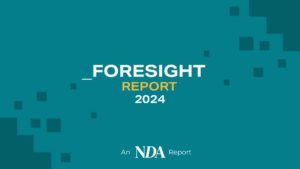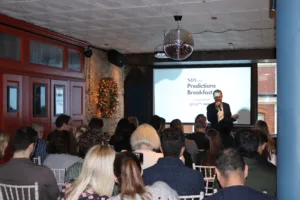Rob Webster is Founder of Canton Marketing Solutions. He’s worked in the adtech industry since 2001 and is NDA’s monthly adtech columnist.
There are a lot of articles right now on the demise of the cookie and surely everything has been said? As a matter of fact, I have yet to see anyone really state what everyone is going to do about it with any kind of clarity. Therefore, today I’m going to look at advertisers, the people that fund digital marketing for a window into the future. The easiest way to think about it is in layers of importance which we will go through, calling out implications as we see them. To that end we have;
- Foundation Layer AKA the GAFA Layer.
- The First Party and Customer Data Layer
- The Identity Graph Layer
- The ID Free Layer
How these four layers prosper and grow will be the cornerstone of all marketing from 2022 and over the next ten years. All of them will be enhanced through ever stronger AI and automation and there will be convergence between them. Yet their differences will remain. As it stands today, I think we can state that three of these layers are certain to prosper with the fourth flourishing, dominating or perhaps being regulated away.
Foundation Layer AKA The GAFA Layer!
Whilst it is not ideal, the dominance that Google, Amazon, Facebook and Apple have ,it is a reality. They take over 70% of digital ad spend and most advertisers need to deal with that first. Indeed, for many advertisers, particularly small and medium sized (SMEs), fixing the core is all they will do at least for the next 18 months as they simply do not have the bandwidth of talent or cash and thus increasing GAFAs share of spend. Apple with its iOS search ads is now a very definite part of this and its planned new ad products will only solidify its place at the top table of advertising.
Paid search, shopping and paid social are the most important direct response channels for most advertisers (again particularly SMEs). By ensuring that advertiser’s core channels are still able to operate efficiently advertisers protect themselves from most problems on the web. There are a number of actions that need to be taken here, from tweaking your tracking settings to upgrading your analytics and consent practices. One thing strangely unremarked on in the press is the historic upgrade of Google Analytics to GA 4, a platform much better suited to the new marketing ecosystem than GA classic. Indeed it is likely that GA 4 will replace the adserver as the source of truth for advertisers. For many that means GA but for some, it will also mean enterprise Customer Data Platforms (see the third section).
- Impact 1- Many advertisers, particularly SMEs, will consolidate to only running with GAFA. GAFA activity, particularly Facebook, will be impacted by the changes but much less than the rest of the industry.
- Impact 2- GAFA will again increase market share of advertising again in the short to medium term.
- Impact 3- Display spending on independent ad tech will be most impacted and decline sharpely for the SME sector. Less retargeting volume and attribution visibility will bite hardest.
- Impact 4- There will be a need from the service industry to improve GAFA installations with clients. Notably in Analytics with GA 4 replacing GA Classic and server side firing for Facebook.
First-Party and Customer Data Layer
The next layer of solutions is around customers and first-party data. First-party data is so important in the ‘privacy-first era’ because it’s the only real way for brands to gain consent for one to one marketing conversations. Some of this data will be existing customers and the rest will be users who have opted into customer marketing but are not yet customers. Getting this right means having a very strong customer relationship management setup and data control (explaining the popularity of customer data platforms) as well as tight control of consent. Getting this right requires expertise and technology that many smaller advertisers either will not have or will choose not to engage in. However, whilst B2B and D2C companies have a smaller overall spend, they have strategic importance and a legacy in lead generation and CRM that will enable those that are progressive to thrive. It will be fascinating to see how consumer brands lacking in first-party data respond. Indeed the need to grow first-party lists may signal a boom time for lead generation efforts.
For advertisers to be able to operate well in this first-party ecosystem it will provide huge advantages as this data and consent combination will not only allow for great customer marketing (and increased lifetime value) but also to power lookalike targeting and attribution. Strong first-party data allows advertisers and publishers to close the loop on targeting and attribution and it’s an area progressive publishers with first-party data are pushing hard.
Advertisers with strong customer data will be able to collaborate well with publishers and data companies that have similar strong first-party data. This will very much include GAFA but also premium connected TV, print and vertical focussed publishers (for vertical publishers think car comparison in the auto space, games reviews in gaming, travel search and content). Allowing this collaboration between different brands’ data is where the customer data platforms and data clean rooms can continue their rapid rise particularly with enterprise and B2B clients. Much of this will take place server to server out of the purview of the browser (interference) and educating customers and gaining consent will be a key part of ensuring the future of different technologies and techniques for future success. It is likely that this space will be dominated by technology geared for enterprise brands, though a big opportunity exists for those able to support progressive smaller companies.
The strategic advantage of authenticated users will drive more and more publishers to become private ecosystems (otherwise known as walled gardens). Much of the pipes and plumbing will still come from open RTB yet with the data kept very privately, leading to a new archetype for independent ad tech. Connected TV publishers, large publishing groups and vertical publishers will join the second tier walled gardens like Snap, Twitter and Tik Tok in a new bulwark against GAFA. This layer won’t all be about direct response either but it will suit the benefits of the publishers involved and in many cases be very brand focussed or as we will discuss below lead gen.
These systems though are not easy to use and require collaboration between marketing and technology. The first-party layer needs for each advertiser to be careful design, implementation and acquire the skills to make the most of it holistically in marketing activity. The strategic importance here and relative lack of available skills will drive the use of new breed service companies who can help advertisers compete in this new ecosystem. Joining up data for seamless planning, targeting and attribution as well as a new operational paradigm are waiting to be designed.
- Impact 5- Advertisers with a strong first-party setup will be able to run customer, lookalikes and attribution activity to a high degree running better marketing than ever before. Advertisers who are not able to build and operate a strong first-party setup will struggle to compete in the privacy-first era.
- Impact 6- The importance of customer data will result in more premium publishers effectively becoming walled gardens. These new ecosystems will join the already successful likes of Snap, Twitter and TikTok to form the biggest bulwark against GAFA.
- Impact 7- The gap in customer data will increase the advantage of large advertisers over small (the same will happen with publishers) which had been in decline in previous eras. The gap in customer data will also shape B2B, D2C and consumer strategy giving an advantage to those who build a strong marketing data framework.
- Impact 8- The need for first-party data and consent will drive a resurgence in lead generation activity. Advertisers (and publishers) will want more consented users in their databases and a lead gen approach for many will be the way forward.
- Impact 9- The huge advantages here will drive the success of CRM, CDP and clean room companies. This data collaboration of first-party ecosystems is materially different from the identity graph layer below (though in some cases connected).
- Impact 10- The strategic importance of the first-party layer combined with its complexity will drive the new breed of support companies where technical skills combined with marketing nous are crucial. The opportunities are enormous but advertisers and publishers will need support to realise them.
Identity Graph Layer
The identity graph layer essentially aims to create new IDs, cookie and MAID replacements that are still able to operate and are matched server to server. This layer, if used to the max, would effectively replace the utility of cookies with a newly upgraded infrastructure. There is a lot at stake here with potentially big advertiser gains as well as huge opportunities (and risks) for the companies that power this space. Yet, all this needs to be balanced against the needs and rights of the consumer and indeed the actions of the giants that run the browsers and app environments. For these reasons, it is this layer that still has by far the most uncertainty about it.
Google has been particularly explicit that they will not support it in their own marketing platform with Apple also against it. Critics of GAFA would say that it is easy to be against it when they have the least need as they dominate logged in users. Of more importance is the attitude that the regulators take to this space and indeed whether consumers view it as a workaround to proposals designed to make them and their data safer. It is this controversy that makes this space unpredictable and also perhaps one that not all advertisers want to operate in. Indeed many identity graphs have pulled out of Europe and other regions due to these concerns.
From most announcements and reading the runes from unofficial comms with the giants, this space will be a crucial part of the future at least for the next few years. For advertisers and publishers that participate, it will allow retargeting and attribution to work much as before. Not all will participate, therefore it will not have the depth and reach of the old world. However, this too may bring improvements to quality and alongside an upgraded approach, improvements in data security.
Probabilistic approaches that might by some definition be called fingerprinting will increase the match rates and utility but also the grey area. All of this will also put ever more pressure on consent technologies and in particular The Consent Framework (TCF).
Geography will also play a huge part. Stricter regulations in the EU and parts of South (and North) America may lessen the utility and viability of this layer. The competing graphs will also have a geographic factor with some technologies being stronger in different territories. It is likely that global advertisers that want a complete solution have to engage with multiple vendors at least in the early years when fragmentation levels are high.
Fragmentation will further be driven by different approaches. Different vendors will have different pricing models, publisher relationships and support structures meaning large advertisers will likely need to consider multiple options for complete coverage before the inevitable consolidation brings the space together in the future.
Many of the identity technologies are relatively expensive right now and the use is limited whilst cookies and MAIDS still exist. For some reason, the industry has moved slowly to fill in the huge gaps in cookie capability that already exist on most non chrome browsers and now in iOS apps. As this cookie gap becomes complete in 2022, many publishers and advertisers will have to decide whether to engage in this layer or not and move quickly. This is going to put a huge demand on expertise to quickly build and operate this layer and makes for an exciting time for those with the skills.
- Impact 11- Those that use identity graph solutions have the most ability to replicate retargeting, data buying and attribution solutions from the programmatic era albeit with less reach than before. There will be a large utility for those that participate.
- Impact 12- Not all advertisers (or publishers) will want to operate in the identity graph space because it may be deemed too controversial.
- Impact 13- The identity graph space will not be the same the world over. Different regulations, culture and publisher engagement will dictate the applicability of solutions around the world. Advertisers will likely need to engage multiple vendors for several years for complete coverage and require support from the service layer to deliver effective marketing.
- Impact 14- Demonstrating consent will be vital to operating in this space. Those that participate will need to double down on the consent implementations and consider the wants and rights of consumers.
- Impact 15- Ultimately the long term future of this layer is in the hands of the regulators. How they view this space will be vital. It is likely that things will be unclear for a considerable time as regulators globally consider their approach.
Identity free Layer.
The most famous identity free solution is Googles FLOC (Federated learning of cohorts) which brings groups to the Google ecosystem. This means that rather than targeting (and measuring) individuals you target (and measure) groups. Fledge and Turtledove are the other avian names that bring auctions to the browser. Despite the fact that we are less than a year from when these systems are used (some would say required) details are still sparse and early tests only now just happening. Furthermore, in Europe, any testing process still needs to get through Google’s lawyers concerned with GDPR implications. Despite all this, it seems highly likely that these Google initiatives are going to be a big part of the future. Google has declared it won’t be participating in the identity layer and so the future of Google display really sits with these initiatives and the views of the regulator.
It’s not only Google’s future either. The Chrome sandbox initiatives are open to use by other ad tech companies. The ability of the participating companies to quickly utilise these systems successfully could be crucial to their success and indeed that of the chrome sandbox initiatives themselves. From here we then move to the many publishers and advertisers that will surely use these techniques. If they work well and are popular with consumers (and activists) from a privacy point of view this will put huge pressure on the Identity layer.
Apple has its own more simplistic but no less important identity free solutions. Most notably the SK ad networks reporting API is only now undergoing its first real-world tests. Such solutions will likely increase to cover Safari. It also may be that Apple continues to flex its muscles in the advertising space with ever more advertising products.
Yet the cookieless solutions of the independent sector could yet prove even more important for independent ad technology, publishers and yes advertisers. There is a huge amount of innovation here where new breed contextual setups are going way beyond the simple keyword lists of old. Geolocation (not too precise) becomes a crucial scalable marketing mechanic that can work across the plethora of ecosystems we have today (with more coming through thick and fast). Third-party data can be reborn with platforms using cohorts to execute across multiple channels.
Measuring attention and brand impact will be crucial to enabling quality publishers to showcase their high-quality upper funnel audiences. Lastly, the creation of new ways to run cross channel attribution relying on a combination of predictive modelling, panels, expose control tests and (restricted) MTA can revolutionise the space for the better. Indeed it is likely we will see a decoupling of premium display from performance as premium publishers look to refine their offerings to where their strengths lie, providing a quality environment for brand marketing and a focus on engagement, attention and video. Performance display may, as already discussed, come to focus as much on lead generation as sales. This space is ripe for innovation and may be the most important part of all as well as the source of giants of the future.
- Impact 16- Google’s chrome sandbox birds of FLOC, FLEDGE and TURTLEDOVE will be a key part of Google’s future with display. Apple too with its own initiatives like SK Adnetworks being crucial to advertising on Apple apps (and likely browsers).
- Impact 17- Google and Apple’s measures will be crucial beyond these giants giving opportunity to ad tech companies, publishers and advertisers that operate in this space.
- Impact 18- Targeting innovation of contextual and Geo (and more) also based around groups (cohorts) by independent tech companies are emerging and can offer hope to independent publishers and indeed power third-party data solutions.
- Impact 19-.A new breed of experts and services will be needed to support the use of these new rich opportunities. This will usher in a new era of media planning.
- Impact 20. Attribution will undergo a renaissance for those that invest in it. AI driven and dramatically sped up media mix modelling will dovetail with platform data, panels, the remnants of MTA and marketing experiments.
What’s most amazing about this future is both the amount of change and the speed of change. These impacts are driven by legislation, by big tech, by the industry’s progress and accelerated by innovation and by the pandemic. Simultaneously, programmatic and platform based techniques are becoming the dominant way to buy and measure all forms of media globally. Never has there been such an opportunity both to succeed as individuals and businesses but also for marketers to build trust with individuals. As we come out of the pandemic a world of opportunity awaits.
I hope to see many of you soon!









